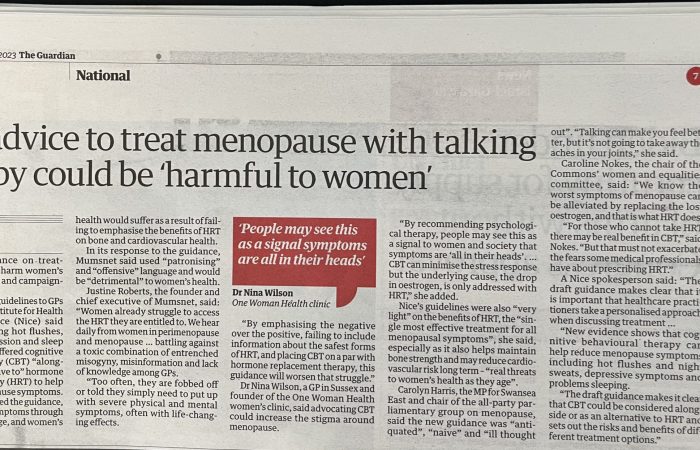What menopause treatment should surgeries be making available to women? A walk through the NICE guidelines for menopause.
As a follow up to our previous article highlighting some of the reasons why some women may be struggling to get help from their GP, in this article we’re delving further and focussing on national guidelines around prescribing for menopause. We’re asking the question ‘what should surgeries be making available to women nationally?’
For the answer, we’re looking to the National Institute of Health and Care Excellence, or NICE for short. NICE regularly publishes clinical knowledge summaries (NICE CKS) and NICE guidelines for the broad range of conditions seen in general practice and hospital medicine. The guideline for menopause care is NG23. The guidelines consist of a set of recommendations that define good practice and outline what the NHS should be offering its patients. As a rule doctors look to these as a benchmark to their practice, to ensure that is up to date and of a high standard. These guidelines apply in England. Scotland publishes similar guidelines known as ‘SIGN’ guidelines. Here we summarise the guidelines about prescription of HRT.
The NICE CKS for menopause subdivides its recommendations according to the main symptoms. The overarching message is: ‘offer a choice of HRT preparation based on the woman’s age, symptoms and background health after discussing risks, benefits and side effects’. Recommendations according to symptoms are paraphrased below:
- Hot flushes and night sweats (also known as vasomotor symptoms): Offer oral or transdermal HRT. If age less than 50, consider offering the combined contraceptive pill as an alternative
- Mood disturbance: Offer a choice of oral or transdermal HRT
- For symptoms affecting the vagina and/or bladder, offer vaginal oestrogen treatment. If, after optimising the dose, that is insufficient to alleviate symptoms, you can use the new medication Ospemifene. However, this depends on it being approved for surgeries to prescribe by the local health commissioners and is not directly under the control of the surgery. Vaginal moisturisers and lubricants can be used alongside vaginal oestrogen and are available on prescription.
- For reduced libido, in some cases called ‘hypoactive sexual desire disorder’, seek specialist advice on the appropriateness of testosterone replacement. When we look across at NICE guideline 23, it says consider testosterone replacement in women if therapy with oestrogen +/- progesterone alone has not improved matters.
So, there you have it. If there is a high probability that a woman’s symptoms are due to menopause/perimenopause and there are no major reasons not to start the treatment, it should be relatively straightforward to access HRT on the NHS. Although I know this is not always the case, this article aims to help readers to understand what is current recommended practice nationally and therefore makes it easier to ask for.
The guidelines clearly state that women should be offered a choice or oral or transdermal therapy (through the skin as a patch, gel or spray). If we read further down in the clinical knowledge summary, it highlights the safety advantages of transdermal HRT. While the guidelines recommend transdermal HRT, in practice, women without risk factors often opt for this over oestrogen tablets too due to the lower risk of clots or stroke.
The situation with testosterone is trickier. The guidelines say doctors can ‘consider testosterone’ in women where low libido remains despite replacement of oestrogen +/- progesterone. Prescription of testosterone in women is ‘off-label’ in the UK. That means that the manufacturer has a licence to produce the product for intended use in men, and use in women is outside their licence. Using medicines off-licence is not especially unusual; there are many medications that are commonly used outside their standard licence and their use in this way is backed up by clinical evidence and experience over time, so it becomes an ‘accepted use’ of the medication. However, in the case of testosterone, many doctors will not be familiar with its use in women and may feel that prescribing it is outside their scope. The doctor’s regulator, the GMC makes it clear in their good medical practice guidance that doctors must always practice within the scope of their skill, training and competence. This may mean your doctor is unable to prescribe testosterone for you.
That said, evidence-based guidance on testosterone use in women is available from the British Menopause Society and many doctors will be familiar with this and happy to prescribe in accordance with these recommendations. This may involve a blood test, as the guidelines state that women with a low level of free circulating testosterone in the blood (a free androgen index <1%) may trial testosterone replacement after discussion of the risks and benefits. Effects may take up to 3 months to be noted hence a trial of 6 months is recommended and if there is no significant benefit then it is recommended the treatment should be discontinued. If any individual clinician is not comfortable prescribing due to relative inexperience with the medication, it is reasonable for them to refer you to a colleague who is experienced, or to a menopause specialist.


